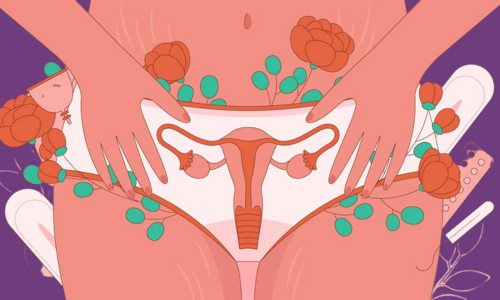More than 50% of women believe that vaginal discharge is responsible for weakness in the body, reduced stamina, or a lean physique.
Women, what are your thoughts?
This is usually the case when specific symptoms like unusual color, irritation, itching, or a foul odor accompany increased vaginal discharge.
To learn more about the topics discussed above, this blog will cover everything about vaginal discharge and its impact on health. We will explore its reasons, colors, types, causes, and available treatments.
What is Vaginal Discharge?
Vaginal discharge refers to a clear or white fluid that exists in the vagina in women. Usually, these discharges are normal; however, their quantity, consistency, color, or smell alterations might indicate an infection or other underlying problem.
Commonly known as leukorrhea, this discharge, observed occasionally in underwear throughout the day, removes dead cells and bacteria.
The main reason behind this is to cleanse and lubricate the vagina, fight harmful bacteria, prevent infections, and maintain the health and cleanliness of the reproductive tract.
What are the Textures of Vaginal Discharge?

The textures of discharge can vary, signifying different states of health. Normally, vaginal discharge is considered healthy if:
- Discharge from watery and sticky to gooey, thick, and pasty.
- The color exhibited is clear, milky white, or off-white
- Carrying a mild odor that is not strong or unpleasant
Let’s explore the different vaginal discharges:
① Thick and White
If there is thick and white vaginal discharge, then there is a possibility that it could indicate a vaginal yeast infection. The common symptoms include vaginal itching, burning, soreness or pain during urinating or having sex, and redness, swelling, or a rash around the vulva.
② Thin with an Unpleasant or Fishy Odor
In this case, vaginal discharge may be thin and have a foul smell, possibly indicating bacterial vaginosis. Symptoms might include itching, burning, slight redness, or swelling of the vagina or vulva.
③ Watery or Unpleasant Odor
Watery discharge or unpleasant odor could be indicative of trichomoniasis. Symptoms may include yellowish or greenish vaginal discharge, as well as pain and itching during urination.
Colours of Vaginal Discharge
Normal vaginal discharge is usually clear white or milky white, while the discharge of other colors is considered to have some problems that will lead to problems such as:
Ⓐ Brown or Red
Irregular menstrual cycles or cervical or endometrial cancer; other symptoms may include abnormal vaginal bleeding or pelvic pain.
Ⓑ Yellow, Gray, or Green
This discharge is usually considered to be a sexually transmitted infection.
Ⓒ Pink
The discharge may be light or a much deeper pink that usually contains some blood.
There are a few reasons associated with it:
- It means the shedding of the uterine lining after childbirth.
- Experiencing some spots after ovulation, which can also be pink discharge.
- After sexual intercourse, sex has caused small tears or irritation in the vagina.
Thick, White, Cheesy
The possibility of yeast infection includes symptoms such as swelling and pain around the vulva, itching, and painful sexual intercourse.
Types of Vaginal Discharge

‣ Normal Discharge
Vaginal discharge can vary in appearance throughout the month. It may vary in consistency, ranging from clear and slippery to white, thick, or even paste-like. The discharge can fluctuate depending on factors such as ovulation, breastfeeding, or sexual arousal. Preteens and those in menopause tend to have less discharge, while menstruating individuals may experience around one teaspoon per day.
‣ During Pregnancy
During this phase, if you see increased discharge during pregnancy is normal and beneficial. It can create a barrier for bacteria to travel from the vagina to the womb. Higher levels of the hormone progesterone, aimed at thickening the uterine lining, contribute to this increased discharge. Moreover, during the end of pregnancy, observing streaks of pink in the discharge may indicate the cervix shedding mucus, a preparation for childbirth.
‣ Before Menstruation
Increased discharge during pregnancy is normal and beneficial. It can create a barrier that makes it difficult for bacteria to travel from the vagina to the womb. Higher levels of the hormone progesterone, aimed at thickening the uterine lining, contribute to this increased discharge.
Towards the end of pregnancy, observing streaks of pink in the discharge may indicate the cervix shedding mucus, preparation for childbirth.
Causes of Vaginal Discharge
Vaginal discharge reasons can stem from various reasons, such as yeast infection, bacterial vaginosis, and menopause. All these conditions make you uncomfortable, but some treatments can help. Before we explore them, let’s learn the reasons for discharge:
There are possible causes.
‣ Causes of White Discharge
- Yeast infection
- Hormonal fluctuations
- Sexually transmitted diseases
- Bacterial vaginosis
- Female healthy vaginal secretions
‣ Thick Discharge Causes
- Ovulation
- Hormonal imbalance
- Vaginitis
- Bacterial vaginosis
Treatment of Vaginal Discharge

Different types of vaginal discharge can lead to various infections, but there are several discharge treatments available to address them. Let’s explore.
• Yeast Infection
The infection causes chunky discharge with a distinct odor, accompanied by slight pain, irritation, or swelling around the vagina. It can be treated with ointments and antifungal creams that effectively treat yeast infections.
• Bacterial Vaginosis
The discharge is a greyish, whitish foul smell that can be treated by taking oral pills, vaginal gels or creams that are used to treat Bacterial vaginosis.
• Trichomoniasis
A parasite causes this sexually transmitted infection. Trichomoniasis can be treated with metronidazole or tinidazole, effectively eliminating the parasite. The couples may require treatment to prevent re-infection.
Prevention tips for vaginal infections and abnormal:
- Avoid wearing tight clothing
- Always wipe from front to back to prevent bacteria from entering the vagina and causing an infection.
- Try to avoid douching or using scented soaps in vaginal areas. Start using sprays and bubble baths.
- Clean your vagina with a gentle, mild soap and warm water externally. Never apply soap directly to the vagina.
Conclusion
We hope that you now have a clearer understanding of the types of vaginal discharge and when it’s essential to consult an IVF specialist.
At Nimaaya IVF center, we prioritize providing comprehensive counseling to women, addressing their inquiries concerning vaginal discharge during pregnancy or menopause
With over a decade of experience in the industry, we have gained immense popularity among
couples and individuals seeking assistance to conceive a baby.








